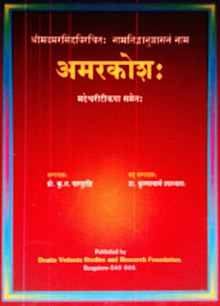Amarakośa
Amarakośa is the earliest surviving Sanskrit ‘dictionary’ (or lexicon), containing lists of synonyms arranged in simple verse.[1] It was written by the Indian scholar Amarasiṃha.[1]
The text is divided into three sections, "covering a wide range of subjects, from the sky, to the earth, to human beings, to language itself. This arrangement provided the model for nearly all subsequent lexicons, and it has been the subject of over forty commentaries."[1]
Title
The name Amarakośa derives from the Sanskrit words amara ("immortal") and kosha ("treasure, collection, dictionary").
This text is also known as Namalinganushasanam, meaning "instruction concerning nouns and gender."
Author
Amarasimha, the author of the text, is said to have been one of the "nine gems" (Navaratna) at the court of Vikramaditya, the legendary king inspired by Chandragupta II, a Gupta king who reigned around AD 400. Some sources indicate that he belonged to the period of Vikramaditya of the 7th century.[2]
Amarasimha was a Buddhist.[3] Oka (1913) states: "...though [the Amarakosha] is a production of a Buddhist, it has been universally accepted as an authority by the Brahmans and Jainas alike."[3]
According to Keith (1956), Amarasiṃha "knew the Mahāyāna and used Kālidāsa."[4]
Mirashi examines the question of the date of composition of Amarakosha. He finds the first reliable mention in Amoghavritti of Shakatayana composed during the reign of Amoghavarsha (814-867 CE).[5]
Contents
The Amarakośa consists of verses that can be easily memorized. It is divided into three kāṇḍas or chapters. The first, svargādi-kāṇḍa ("heaven and others") has words about heaven and the Gods and celestial beings who reside there. The second, bhūvargādi-kāṇḍa ("earth and others") deals with words about earth, towns, animals, and humans. The third, sāmānyādi-kāṇḍa ("common") has words related to grammar and other miscellaneous words.
Svargādikāṇḍa, the first kāṇḍa of the Amarakośa begins with the verse 'Svar-avyayaṃ-Svarga-Nāka-Tridiva-Tridaśālayāḥ' describing various names of Heaven viz. Svaḥ, Svarga, Nāka, Tridiva, Tridaśālaya, etc. The second verse 'Amarā Nirjarā DevāsTridaśā Vibudhāḥ Surāḥ’ describes various words that are used for the hindu Deva-s (Gods). The fifth and sixth verses give various names of Buddha and Śākyamuni (i.e. Gautam Buddha). The following verses give the different names of Brahmā, Viṣṇu, Vasudeva, Balarāma, Kāmadeva, Lakṣmī, Kṛṣṇa, Śiva, Indra, etc. All these names are treated with great reverence.[6][7] Amarakośa reflects the period before the rise of sectarianism. Commentaries on Amarakosha have been written by Hindu, Jain and well as Buddhist scholars.[8]
The second kāṇḍa, Bhuvargādikāṇḍa, of the Amarakosha is divided into ten Vargas or parts. The ten Vargas are Bhuvarga (Earth), Puravarga (Towns or Cities), Shailavarga (Mountains), Vanoshadivarga (Forests and medicines), Simhadivarga (Lions and other animals), Manushyavarga (Mankind), Bramhavarga (Brahmana), Kshatriyavarga (Kshatriya), Vysyavarga (Vaishya) and Sudravarga (Sudra).[citation needed]
The Third Kanda, Sāmānyādikāṇḍa contains Adjectives, Verbs, words related to prayer, business, etc. The first verse Kshemankaroristatathi Shivathathi Shivamkara gives the Nanarthas of the word Shubakara or propitious as Kshemankara, Aristathathi, Shivathathi, and Shivamkara.[citation needed]
It is still used as one of the major source of Sanskrit grammar. It was widely taught in gurukulas. One of the finest collections till date.
Commentaries
This text has been the subject of over forty commentaries.[1] These include:
- Kavikāmadhenu by Subhūticandra
- Amarakoshodghātana by Kṣīrasvāmin (11th century CE, the earliest commentary)
- Tīkāsarvasvam by Vandhyaghatīya Sarvānanda (12th century)
- Rāmāsramī (Vyākhyāsudha) by Bhānuji Dīkshita
- Padachandrikā by Rāyamukuta
- Kāshikavivaranapanjikha by Jinendra Bhudhi
- Pārameśwari by Parameswaran Mōsad in Malayalam
- A Telugu commentary by Linga Bhatta (12th century)
Translations
"Gunaratha" of Ujjain translated it into Chinese in the 7th century.[9]
The Pali text Abhidhānappadīpikā, composed in the twelfth century by the grammarian Moggallāna Thera, is based on the Amarakosha.
Notes
- ↑ 1.0 1.1 1.2 1.3 Amarakośa. Oxford Reference. Retrieved 16 Sep. 2023, from [1].
- ↑ Amarakosha compiled by B.L.Rice, edited by N.Balasubramanya, 1970, page X
- ↑ 3.0 3.1 Oka 1913, p. 3.
- ↑ Keith 1956, p. 413.
- ↑ Literary and Historical Studies in Indology, Vasudev Vishnu Mirashi, Motilal Banarsidass Publ., 1975, p. 50-51
- ↑ Encyclopaedia of Indian Literature: Devraj to Jyoti, Volume 2, Editor Amaresh Datta, Sahitya Akademi, 1988 p. 1036
- ↑ A History of Indian Literature, Moriz Winternitz, Motilal Banarsidass, 1985, p. 494
- ↑ Anundoram Barooah Makers of Indian literature, Biswanarayan Shastri, Sahitya Akademi, 1984p. 79
- ↑ Oka 1913, p. 9.
Sources
- Amarakosha at sanskritdocuments.org
- Amarakosha files Archived 2010-06-24 at the Wayback Machine. by Avinash Sathaye
- Keith, A. Berriedale (1956), A History of Sanskrit Literature, Great Britain: Oxford University Press
- Oka, Krishnaji Govind (1913), The Nâmalingânusâsana (Amarakosha) of Amarasimha; with the commentary (Amarakoshodghâtana) of Kshîrasvâmin, Poona City: Law Printing Press
External links
- Knowledge-Net of Amarakosha, Department of Sanskrit Studies, University of Hyderabad. (a search engine based on the Amarakosha)
| This article includes content from Amarakosha on Wikipedia (view authors). License under CC BY-SA 3.0. |
